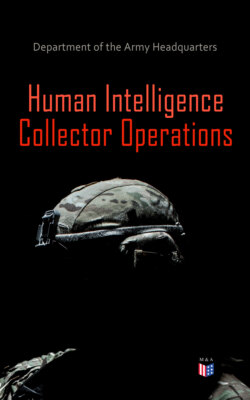Читать книгу Human Intelligence Collector Operations - Department of the Army Headquarters - Страница 75
На сайте Литреса книга снята с продажи.
DEVELOP HUMINT REQUIREMENTS
Оглавление4-17. The first step in the RM process is to develop intelligence requirements that accurately identify and prioritize the commander’s concerns about the threat and the battlefield environment that must be resolved to accomplish the mission. The G2/S2X, or his representative, normally supports the G2/S2 by identifying HUMINT collection requirements and opportunities and advises the command and staff on HUMINT capabilities. The HUMINT representative must be able to discuss any delays or risks involved in using HUMINT assets. Through participation in the requirements development process, the HUMINT representative has a thorough understanding of the commander’s intent and concept of operations and is better able to support the overall ISR effort.
4-18. The analysis of HUMINT requirements is normally a coordinated effort between the HUMINT and CI staff officer (C/J/G/S2X) and the HAT of the supporting analysis element. The C/J/G/S2X team—
Records all HUMINT requirements whether generated internally (Specific Orders) or received from other echelons or units (Requests).
Tracks each requirement from receipt to final satisfaction.
Reviews each requirement for its—Feasibility. Feasibility is a determination if a requirement can be answered given available time and resources.Completeness. Does the requirement contain all the specifics needed for collection, such as: What the collection requirement is? When the latest time information is of value (LTIOV)? Why it needs to be collected? Who needs the results of the collection?Necessity. The C/J/G/S2X team, with the assistance of the HAT, checks available intelligence databases to determine if the required information has already been collected or is included in an intelligence product.
4-19. The RM team, with the assistance of the C/J/G/S2X team and the HAT, breaks the HUMINT-related PIR into SIRs. Each SIR describes the indicator of threat activity linked to an area or specific location and time. The HOC evaluates—
Reportable criteria that are linked to the threat activity. The HOC associates these characteristics with a SIR, and compares the characteristics to a particular HUMINT asset’s capability to collect.
Range, which is the distance from the current location of the HUMINT asset or resource to the source. In other words, are there sources available that had or have access to relevant information on the area or activity in question, and can the HUMINT team contact them in a timely manner?
Timeliness, which is when the information must reach the commander to be of value; that is, the LTIOV.
4-20. The RM team, supported by the C/J/G/S2X and the HAT, attempts to answer the SIRs with intelligence products developed from information available within the existing intelligence databases or pulled from other organizations within the intelligence architecture. If the requirement can be answered in this manner, the intelligence is immediately disseminated. When the required information is neither available nor extractable from archived information or from lower, lateral, or higher echelons, the C/J/G/S2X team develops it into an RFI to higher or an ISR tasking for organic or attached HUMINT assets. The compilation of unanswered requirements and how to answer them form the basis of the ISR plan. The tasking may be in the form of an SDR. An SDR is a specific request or tasking for a collector to question a source on a particular collection requirement. This request involves analysis that results in the conclusion that a specific source possibly has the placement and access to answer a SIR. SDRs are specific; whereas, HUMINT collection requirements (HCRs) are general.
